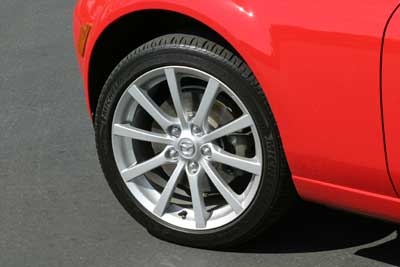Recent Articles
Popular Makes
Body Types
2006 Mazda MX-5 Miata Road Test
Terrific moves and a great body, but a face only Mom could love
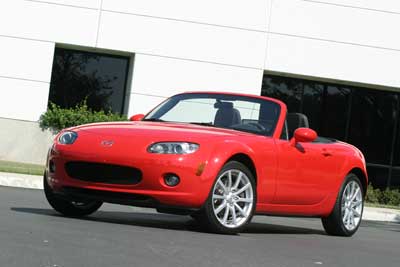
TO THE POINT What’s New? Completely redesigned, with more power, better handling, and additional space. But the styling leaves us flat. Selling Points: Refined and powerful engine, excellent brakes, steering and tire grip, compliant suspension, upscale interior. Deal Breakers: Funky front styling, narrow and stiff seats, hard plastic cupholders on the door panels Our Advice: Nothing provides bang for the buck like the 2006 Mazda MX-5 Miata. Improving an icon is dicey business. Ask the Coca-Cola Company what happened with that new recipe they tried back in the 1980s, or Jeep how folks felt about square headlights on the 1987-1995 Wrangler. And don’t even get us started on Disney World’s Epcot Center. Facing the challenge of crafting something all-new, yet comfortably old, is daunting at best, but to a large degree Mazda has found success with the redesigned 2006 MX-5 Miata. Loved and cherished by enthusiasts around the globe, the Mazda Miata jump started the modern roadster renaissance when it debuted for the 1990 model year. Its design principle was a simple one: , a Japanese phrase loosely translated to mean horse and rider as one. To its credit, the company has successfully managed to keep its elemental sports car light, lithe, and incredibly responsive during its 16-year run, despite increasingly stringent safety and emissions regulations. Those attributes remain intact with the all-new 2006 Mazda MX-5 Miata, a car that represents a dynamic home-run yet breaks little new ground as a sum of its parts. In many ways, the new version is a big improvement over the old car, but in just as many ways, the old car is preferable to the new version. And with sexy new entries from Pontiac and Saturn arriving to steal market share from Mazda, the somewhat dowdy MX-5 has its work cut out for it. Nevertheless, dynamics are what the Miata has always been about – not comfort, not aesthetics, not luxuries. This car is to a driving enthusiast what Chimay Ale is to a beer connoisseur or Tiffany and Co. is to a gold digger. It is aspirational, not as defined by price or prestige but by freedom. The 2006 Mazda MX-5 is your ticket to ride, a cheap thrill that lasts a lifetime, an escape clause in the daily grind. Even if the front end is homely, we still love this car.
Performance
Key Points • 2.0-liter, DOHC four-cylinder engine • 170 horsepower at 6,700 rpm (manual) • 90 percent of peak torque between 2,500 and 6,700 rpm • 5- or 6-speed manual, or 6-speed auto Smooth, seamless, linear power is available throughout the 2006 Mazda MX-5 Miata’s powerband. This new motor is a gem, a big improvement over the previous-generation’s rather rough 1.8-liter engine. The two-liter loves to rev, is extremely refined, and seems to beg for abuse, yet returned an impressive 24.4 mpg during our week behind the wheel of a Sport model equipped with a six-speed manual transmission. That six-speed featured a light clutch and a fluid shifter, and even the most ham-handed drivers never missed a shift. There’s also more room in the footwell for folks with large feet to perform heel-and-toe downshifts.
One test driver, when asked if the new MX-5 is fun to drive, replied: “Yeah! Crazy, stupid, @!&#-eating-grin fun. The MX-5 can be driven right at the limits because it remains forgiving, but it’s just as much fun at low speeds where it’s a drop-top, point-and-shoot traffic mauler.” He’s on Ritalin now, and much calmer.
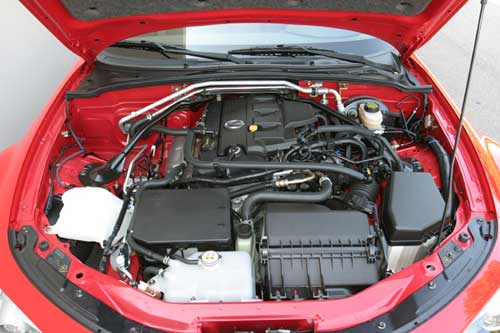
Handling
Key Points • Weight gain is limited to 27 pounds • More rigid, better balanced structure • Double wishbone front suspension, multi-link independent rear • ABS and stability control optional Few sporting automobiles can supply razor sharp response with a compliant ride quality, but the 2006 Mazda MX-5 manages just that. Even when equipped with the optional Sports suspension package, the MX-5 soaks up bad pavement like mechanical Bounty, delivering a terrific ride that makes this car comfortable for all-day drives. Trouble is, the soft underpinnings sometimes make the MX-5 feel unsettled on badly pockmarked roads. Handling is impressive on smooth pavement, the steering responding instantaneously to commands. Dial in too much guidance, and the MX-5 will transition its weight a bit more abruptly than expected. We also disliked the amount of body roll in harder corners and the way that the steering wheel dances beneath your fingertips, quivering and tugging over every surface change. Nevertheless, the busy steering communicates loud and clear, and the Michelin Pilot Preceda tires are phenomenal, offering incredible grip accompanied by very little squeal in the tightest and quickest of corners. Braking, too, is exceptional. The binders on our test vehicle performed flawlessly, with terrific brake pedal feel, travel, and modulation. No matter how hard we used them, the brakes resisted fade, pulsation, and grinding. The 2006 Mazda MX-5 Miata might feel a little too light and lively at times thanks to its compliant suspension and constantly vibrating steering wheel, but the car is always ready for action. You’ve just gotta use some finesse to extract maximum performance.
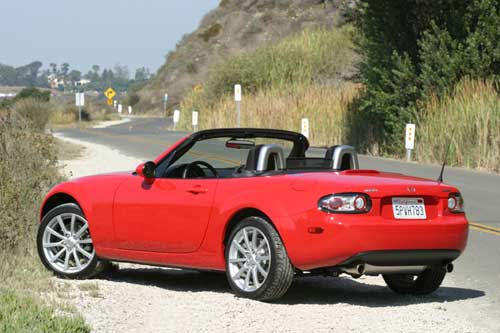
Interior Comfort
Key Points • Fore/aft seat travel increased two inches • More substantial seat bolsters • New mesh windblocker, taller rear bulkhead reduce wind buffeting • Parking brake lever on right side of center console • Cupholders located where knee rests or braces during spirited driving
In making the redesigned 2006 Mazda MX-5 Miata friendlier to taller people, the driving position is lower to the floor in deeply-dished seats that have firmer bolsters. In combination with a taller dashboard and cowl, the seating will seem too low to drivers familiar with the old Miata, and there is no seat height adjuster. The side sills are higher, too, and covered with material that is pliable but not nearly as comfortable to elbows as the softly-padded sills of the old car. At least the driver’s foot well has some extra room, appreciated by folks with larger feet. The three-spoke steering wheel is a joy to grip, despite a lack of thumb rests, but the view over the hood feels less expansive. Gone is the curvaceous bubbled bonnet of the old Miata, replaced by a bulbous beveled hood which looks like that of an original Dodge Durango from the driver’s seat.
Despite added leg room, head room, and interior space, we find the 2006 Mazda MX-5 to be less comfortable than its forebear. The main reason for this, aside from the lower seating position and more restrictive seat bolsters, is the design of the door panel. We can’t print the language one test driver used to describe the hard plastic cupholders that are molded into the door panels, but clearly Mazda has forgotten that a Miata is for driving, not sipping a . These hard plastic protrusions are located exactly where your leg wants to brace for hard right-hand corners, and rest for highway cruises.
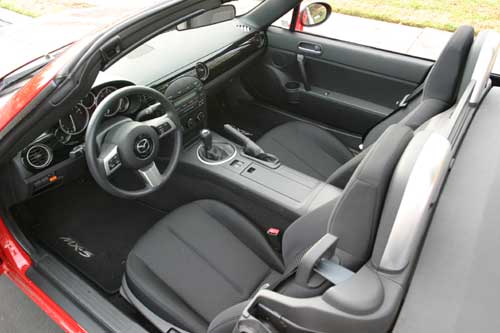
Interior Design
Key Points • Hooded gauges, four round air vents convey signature elements • Piano-black trim on dashboard provides upscale appearance • Four cupholders for a two-seat sports car. Ridiculous. • Simple, elemental gauges that are beautiful and easy to read Four cupholders are not necessary in a two-seat sports car. Come to think of it, two cupholders are too much in a vehicle designed first for driving and second for everything else. We can live with those in the center console, even if they make it harder to shift when in use. Mazda needs to ditch the hard plastic cupholders molded into each door panel. Otherwise, there is little to fault when it comes to the 2006 Mazda MX-5 Miata’s design and materials. Most surfaces are covered in hard plastic, unlike the soft-touch dash pad and door panel trim of the old Miata, but it’s of the low-gloss, even patterned variety. The leather-wrapped steering wheel is soft and smooth, and the checkered-insert seat fabric looks subdued and feels durable. Overall, this is a big step forward from the old model. Vaguely retro in style, the MX-5 Miata’s interior looks good, especially when decked out in Saddle leather. We think the cowl is too high, but like the flashy new steering wheel, perfect gauges, and restrained use of silver plastic trim.
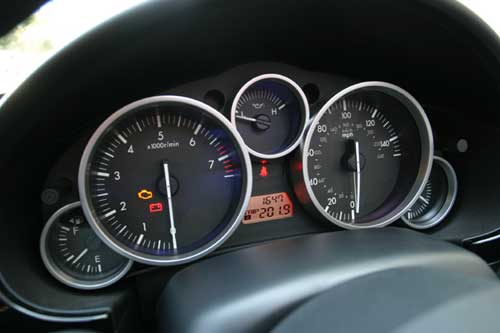
Control Layout
Key Points • Passenger airbag on/off switch standard • Optional Bose audio system • Available steering wheel controls for stereo and cruise control • Paddle shifters provide manual control of optional automatic Simplicity governs the layout and design of the 2006 Mazda MX-5 Miata’s controls, with few exceptions. Check out the four recessed rocker switches under the main stereo display. Those look like they’ll fill with grit that only a Q-Tip can remove, an odd design for a car with a top that should be down unless it’s raining or the temperature has dropped below 50 degrees. We also found it awkward to use the power mirror and power door lock switches on the door panel, and while driving we kept shutting off the power to the audio system when reaching for a radio station pre-set button. Except for those minor complaints, the Mazda MX-5 Miata’s cabin is easy to use, even if some controls are small and closely grouped because of real estate constraints. Perhaps most impressive is that the LCD readout for the stereo is visible even when the sun is shining directly on it. Our MX-5 Sport test model had the standard stereo setup, not the optional Bose system, but it was capable of overcoming wind roar and traffic whoosh on L.A.’s notorious multi-lane freeways. It features special modes for better listening with the top down, and the climate control system includes unique ventilation modes, too.
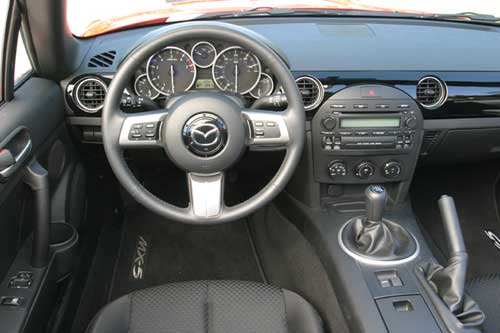
Storage and Cargo
Key Points • Four cupholders • Bigger trunk but smaller opening • Larger storage areas but door panel slots are gone • Upper trims include covered bins behind the seats Pop the new 2006 Mazda MX-5 Miata’s trunk lid, and you’ll see a slightly larger space accessed through a smaller opening. One reason the trunk is larger is that Mazda has ditched the spare tire. You get a standard inflator kit, or you can buy the optional run-flat tires. Though the trunk is larger in volume, its usefulness is diminished by the smaller opening. No longer can you just plop a garment bag flat onto the trunk’s floor and be on your way. Now you’ve got to drop it in end first, and then squish it down at an angle to get the lid closed. Inside, storage is improved through a larger center console tray that doubles as a cupholder and a new bin located between the seats on the rear bulkhead. The glovebox is a bit larger, and there’s a deep slot located on the lower driver’s side of the dashboard. The hard plastic sunvisors have integrated card clips, and just forward of the shifter is a small tray. The most impressive addition to the new MX-5 Miata, however, are the large covered bins located behind the seats on upper trim levels. For a 2,500-pound car with just two seats, the MX-5 Miata isn’t short of storage space.
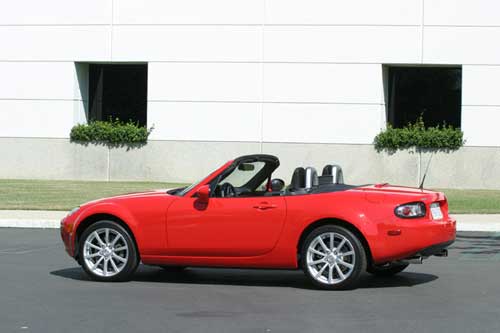
Exterior Design
Key Points • Hoodline meets European pedestrian crash compatibility standards • Design cues recall original Miata and the RX-8 sports car • Coke-bottle side contours eliminated • new convertible top design creates semi-hard tonneau when folded • Detachable hardtop is optional If there’s anything about the new 2006 Mazda MX-5 Miata that might turn loyalists off and keep new customers from buying one, it’s the front styling. To meet European pedestrian crash compatibility standards, the new MX-5’s hoodline needed to be raised significantly over the old car. The result is a long, flat hood and round, bulbous front end that looks like a Japanese cartoon character more than it does anything else. Mazda tried hard to soften the appearance forced by the tall hoodline, but the headlights and grille sit too high in relationship to the wheels, and while the odd blistered wheel arches serve to break up the acreage between the tops of the wheels and the crest of the hood, they look just as strange here as they do on the RX-8. Look at this car, and now look at a Pontiac Solstice or Saturn Sky. Which one do you want to drive? Or be seen in? Mazda has been hyping the simplicity of its new top on the 2006 MX-5 Miata, but it’s not really easier to use. With the new car, a single header latch must be released, and then the top folds down behind the seats. To secure the top, it must be latched by pushing down on its leading edge. Raising the roof requires that the latch be released using a lever on the bulkhead, and then the driver must reach back over the high rear bulkhead and pull the top up. In the old car, you flip two latches and toss the roof over your head. Sure, it lies in an ugly pile of glass and fabric unless you snap the flimsy tonneau cover on, but so what? Raising it is just as simple. The rear bulkhead on the old car is also lower, making it easier to grab the top’s header bar, yank it back over your head, and snap the two latches into place. Wind buffeting is reduced with the new car because the driver sits lower than before, but the old model did a fine job of reducing drafts, too.
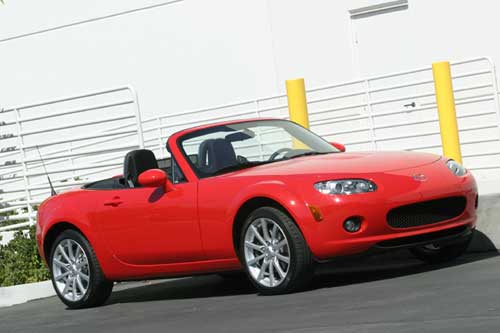
Build Quality
Key Points • Miata enjoys a long history of reliability • New MX-5 Miata’s build quality is disappointing According to magazine, the Mazda Miata is one of the most reliable cars on the market, and regularly lands on its recommended list for that reason. One of our staff members has owned four Miatas over the years, and aside from clutch problems on his 2001 British Racing Green edition (and the utter incompetence of almost every Mazda dealer that has serviced his vehicles), his personal vehicles haven’t given him a bit of trouble. That’s why the build quality of our 2006 Mazda MX-5 test car distressed us. Rarely were we able to get the Z-fold top to collapse on the first try, and when it was raised there was a loose flap and an air leak on the passenger’s side of the cabin. Furthermore, the trunk lid and the driver’s door were crooked, and the front fascia was slightly tweaked. But one thing is for sure; the panel gaps on this new Miata are extremely tight. Inside, the top of the gauge binnacle pops right off in your hands with little provocation, just like a GM product made 10 years ago. Compared to the solidly affixed unit in the previous generation model, Mazda ought to consider this an embarrassment. Beyond that, the plastic housing for the top release was loose, the mesh windblocker between the seats felt brittle and ripe for breakage, and our car had a piece of a gasket foam sticking out from between the right side of the dashboard and the A-pillar.
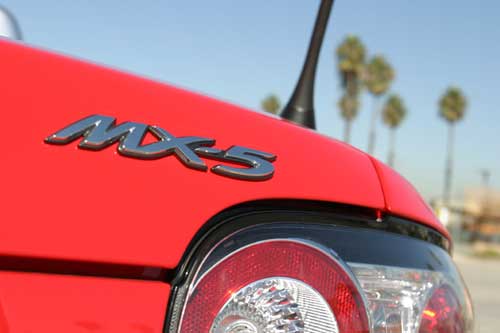
Miata vs. Solstice
Key Points • MX-5 is the more refined car • Solstice is the sexier car • MX-5 powertrain is smooth, powerful and refined • Solstice steering and handling are superior • Solstice is very cheap on the inside Sixteen years ago, the Mazda Miata redefined a dead segment, spawning in the process a roadster revival that continues unabated today. As evidence, enthusiasts have been panting in anticipation for the arrival of the 2006 Pontiac Solstice, and now that the Solstice is on the road, everyone wants to know how it stacks up to the iconic MX-5 Miata, which is also all-new for 2006. We happened to be driving the new MX-5 Miata the week we took our test drive in the Solstice, and though we didn’t drive them back-to-back, here are our unvarnished impressions based on an unofficial comparison “test”: Powertrain – Miata has a slicker shifter with shorter throws, and a more refined engine that is happy to run to the red. Solstice has a Colorado pickup truck gearbox with whine, lash, and longer throws that are sometimes clunky. Plus, we kept third gear during quick downshifts. Solstice’s engine has a pleasing burble at low rpm, but the engine whines and thrashes as revs climb. Plus, the distance between the gearing in second and third is cavernous. Advantage = MIATA. Braking – Miata pedal feels better with more natural progression and easier modulation. Solstice features less travel and feel. Brakes on either car are effective. Advantage = MIATA. Handling – Miata’s steering is razor sharp, almost darty, and the steering wheel vibrates excessively in the driver’s hands. Plus, Miata exhibits a bit more body roll in tight turns. Solstice feels solidly planted, features very little body roll, and the steering is linear and light off center with a pleasing heft on center. Solstice’s wheel doesn’t dance in your hands like the Miata. The Pontiac is more confidence inspiring, even if the Solstice’s added heft is evident. Advantage = SOLSTICE. Ride Quality – Solstice is a little more firm than Miata, feeling solidly planted but a bit more ponderous. Miata is lighter on its feet and better at soaking up bumps, but feels less connected to the road. Neither car beats up occupants. DRAW. Fun to Drive – Miata is better at going and stopping, while Solstice is better at turning and handling. Differences, however, between powertrains and that light, tossable feel every roadster should have, weigh in favor of the Miata. Advantage = MIATA. Comfort – Solstice has nice flat door panels and center console trim. Miata sticks cupholders on the doors, fer cryin’ out loud, which can dig into the driver’s left knee and cause painful bracing in quick right-handers. Both seats have more lumbar support dialed in than some might prefer. Miata quells wind buffeting better and has a superior trunk design, but Solstice is easier to get into and out of. Miata’s top is simpler to use. Advantage = MIATA. Quality – Miata is a paragon of refinement compared to Solstice. Solstice has too much cheap, GM-truck-grade plastic slathered all over the interior. Plus, the Solstice’s exterior build quality was terrible, though our sample MX-5 could have used more attention to detail, too. Advantage = MIATA. Design – Solstice is sexiest car on the outside, while Miata is preferable inside (except for stupid door-mounted cupholders). Ergonomically, it’s a draw. Advantage = SOLSTICE.
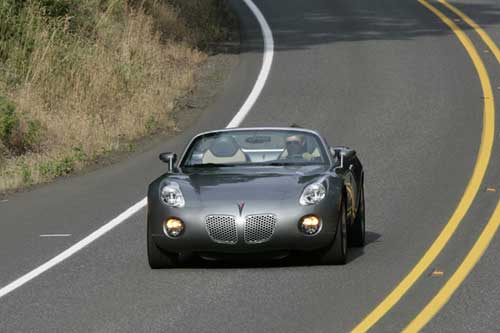
Specifications
Key Competitors • Pontiac Solstice • Saturn Sky Test Vehicle: 2006 Mazda MX-5 Miata Sport Price of Test Vehicle: $24,495 (including $560 destination charge) Engine Size and Type: 2.0-liter inline four-cylinder Engine Horsepower: 170 at 6,700 rpm Engine Torque: 140 lb.-ft. at 5,000 rpm Transmission: Six-speed manual Curb weight, lbs.: 2,498 EPA Fuel Economy (city/highway): 24/30 mpg Observed Fuel Economy: 24.4 mpg Length: 157.3 inches Width: 67.7 inches Wheelbase: 91.7 inches Height: 49 inches Leg room: 43.1 inches Head room: 37.4 inches Max. Seating Capacity: 2 Max. Cargo Volume: 5.3 cubic feet Competitors: Pontiac Solstice, Saturn Sky
